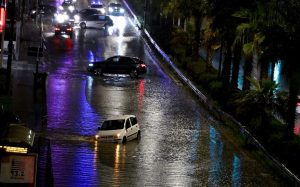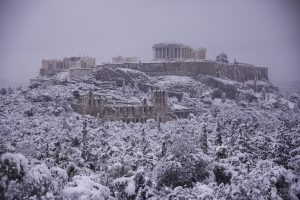NARVA, Estonia—The city council of Narva sits just a few steps from the border crossing with Russia, on a square named after Russian Emperor Peter the Great. Almost everyone here in Estonia’s third-largest city speaks Russian as a mother tongue, and one out of three residents hold Russian rather than Estonian citizenship.
Back in 1993, before the Baltic country joined the European Union and the North Atlantic Treaty Organization, Moscow-backed Narva council members organized a referendum on regional “autonomy,” a byword for alignment with Russia. Estonia rejected the vote, in which residents backed the proposal with a turnout of 54%, as a grave threat to its independence and territorial integrity.
That separatist fervor has dissipated for now, at least in the open, but the danger from Russia hasn’t. The once bustling border bridge over the Narva River has been closed to vehicles since February, part of the rapidly deteriorating relationship between the two countries. Antitank concrete pyramids are arrayed on the span where locals used to routinely drive to fill up with cheaper Russian gas. At the Estonian border checkpoint for pedestrian traffic, notices ask people walking in from Russia to share information about security threats to Estonian statehood.
Months after the invasion of Ukraine in 2022, Russian President Vladimir Putin publicly described Narva, a city of 53,000 people, as historically Russian land. His government has since issued an arrest warrant for Estonian Prime Minister Kaja Kallas for her government’s orders to remove monuments to Soviet troops. She is the only foreign leader known to be on the Kremlin’s wanted list.
Though few expect Russia to strike Estonia militarily in the immediate future, the U.S. and European governments are increasingly concerned that Putin plans to test Western resolve by challenging members of NATO, particularly the three Baltic states that had been ruled from Moscow, if he succeeds in ending the war in Ukraine on favorable terms.
“We know that Russia is aggressive. It’s like a murderer: It has the intent and the means, it just needs an opportunity,” said Tomas Jermalavičius , head of studies at the International Centre for Defence and Security, a think tank in Estonia’s capital, Tallinn.
Such concern was a key reason House Speaker Mike Johnson , defying resistance among fellow Republicans, pushed through the $60 billion aid package for Ukraine . “Vladimir Putin would continue to march through Europe if he were allowed,” Johnson said, explaining his support for the funding, which, after a Senate endorsement, was signed into law by President Biden last week.
Putin has dismissed warnings of a potential Russian attack on NATO members like Estonia as “complete nonsense.” In early 2022, the Kremlin used similar language to ridicule American warnings that Russia planned to invade Ukraine.
“The threats are not potential or theoretical,” said Jonatan Vseviov , secretary-general of Estonia’s Foreign Ministry. “Russia has made no secret of what its goals in this war are. It is to control all of Ukraine and to fundamentally reshape European security architecture by creating a sort of buffer zone on its western borders, in the process destroying NATO and the European Union as effective security organizations.”
From investments in the military to diplomatic and intelligence efforts, Estonian—and other Baltic—officials say they are working to meet the looming challenge. “We are not next because we always prepare to avoid being next,” said Maj. Gen. Ilmar Tamm , commander of the Estonian Defense League, a paramilitary organization that would supplement the regular military in case of war and that has increased its recruitment and readiness levels since the invasion of Ukraine. “It’s not just a response to Russia but a logical preparation for what we need to do anyway.”
On its own, Estonia, home to just 1.4 million people—nearly one-third of them Russian speakers—is hardly a match for the Russian military. “If there is a war here, it won’t be like in Ukraine because we are such a tiny country. Our entire population is smaller than the Russian military,” said Narva Mayor Jaan Toots . “NATO would have to defend us.”
Ground troops from other NATO members, including the U.S., have been deployed in the Baltics since 2017 and reinforced after the invasion of Ukraine. Numbering some 5,000 service members in total, they are far too few to resist a full-scale military thrust.
Places such as Narva and the surrounding countryside of eastern Estonia are among the most obvious targets for a Russian probe, as are the “Suwalki corridor” between Poland and Lithuania, and the Russian-speaking areas of eastern Latvia, Western officials say.
As Putin compared himself to Peter the Great in June 2022, saying that both rulers were on a mission to regain historic Russian lands, he specifically mentioned Narva, the site of two major battles between Russia and Sweden in the early 18th century. In his autobiography, he also claimed that his father had been betrayed to the Nazis by Estonian villagers during World War II.
The rise of isolationist voices in the U.S., including former President Donald Trump ’s remarks that he would invite Russia to invade European allies who don’t pay enough for NATO protection, has already eroded the alliance’s deterrence, warned Anton Hofreiter , head of the European Union affairs committee in the German Bundestag.
“I am concerned that because of unclear signaling from the West, we may mislead Putin into thinking that he can attack without too harsh a consequence,” Hofreiter said. “Say, he would attack Narva and say the next day it’s now part of Russia and is under a Russian nuclear umbrella, and what will you do now?”
Estonia has already sustained a series of Russian cyberattacks that aimed to cripple its infrastructure, and Russian GPS jamming in recent days caused two Finnair flights to abort landing in Tartu airport and turn around. The Finnish company said Monday that it is suspending services to Tartu.
Some of the most severe ones followed political events, such as Estonia’s decision to remove Soviet war memorials or the Estonian parliament declaring Russia a terrorist state in late 2022, said Gert Auväärt , director of Estonia’s National Cyber Security Center.
“Cyberattacks are part of the diplomatic toolbox for the Kremlin,” he said. “They want to send a strong signal that they can disrupt and to show that Western societies are unable to keep their people safe and secure.”
Estonia’s domestic intelligence service said in February that it had arrested 10 people who had been recruited by Moscow to foment low-level unrest, including attacks on cars of the current interior minister and a prominent journalist. It provided no further details.
“They have already made the next step, not only a cyberattack but also a physical attack,” said Estonian Defense Minister Hanno Pevkur .
When it comes to a more conventional military threat, Pevkur estimated that it would take Russia two or three years to rebuild its forces to seriously challenge NATO. “In the coming months, in the foreseeable future, so long as the Ukrainian war is ongoing, I do not see that Putin is ready to open a second front,” he said. “It would be catastrophic for him.”
Pevkur briefly interrupted an interview because Russian warplanes, once again, had to be intercepted as they flew into Estonia’s airspace.
Estonia and Latvia, unlike Lithuania, didn’t grant automatic citizenship to all their residents when they restored independence in 1991. That left hundreds of thousands of Russian speakers who had come from the rest of the Soviet Union after World War II, and their descendants, with a choice of remaining stateless “noncitizens,” opting for Russian passports or having to pass language exams to qualify for naturalization.
Residents regardless of citizenship can vote in local elections—a right that Estonia’s government is now moving to remove for holders of Russian and Belarusian nationality, alongside a switch from Russian to Estonian language education in cities such as Narva.
Unlike in the 1990s, when pro-Russian separatist politics posed a serious threat, Estonia’s prosperity as a member of the EU makes any unrest unappealing even to the most pro-Putin residents, said Katri Raik , who served as mayor of Narva until last September and is a former interior minister.
While Russian intelligence could find “some homeless Oleg who spends his time drinking beer and manipulate him via Facebook and TikTok,” the pool of such potential collaborators is small, she said. “There is no fifth column here,” Raik said. “People are not dumb, and they know where life is better, here or in Russia.”
Still, more than three decades into independence, Estonian citizens make up less than half of Narva’s population. While overt displays of Russian nationalism, such as black and orange St. George’s ribbons, and support for the invasion of Ukraine are outlawed in Estonia, the sympathies of many in town are clearly with Putin.
“It’s a state within a state in Narva, though few are willing to admit it,” said Maria Smorzhevskihh-Smirnova , director of the Narva Museum who was pilloried on local social media and by some city council members for an exhibition that compared the destruction of historical Narva by Soviet troops in 1944 to the flattening of Ukrainian cities by Russia in the past two years.
Hardly anyone from Narva’s original Estonian population returned to the city’s ruins after World War II, and a new city of Soviet apartment blocks was erected in its stead by settlers from Russia.
“When the building of an independent Estonian state began, people in Narva had this different sensibility: Russians have always lived here, why do we need to learn Estonian, the border with Russia is open and right here, why do we even have to bother?” Smorzhevskihh-Smirnova said.
A Ukrainian refugee who moved to Narva after the invasion said he has made a rule not to discuss politics with locals because so many of them support Putin. Though Estonia has barred Russian TV channels from its cable network, proximity to Russia means that Russian broadcasters—and their propaganda—are readily accessible to local residents. Very few locals are willing to be interviewed, because openly supporting Putin can violate Estonian law, while criticizing the Russian regime could create problems across the border.
Nadezhda Shibello , 60, who came to Narva from Siberia when she was 20 years old and still has many relatives in Russia, said she now suffers from nightmares about imminent war.
“Our people keep saying that Putin will come here. I don’t think so, but if something happens, if there is a provocation from the Estonian side, of course he won’t remain silent, there will be a reply,” she said as she walked from a shopping trip to Russia. “To be honest, I am so uneasy. Estonia is so small, one bang and it is all gone.”
Write to Yaroslav Trofimov at yaroslav.trofimov@wsj.com


